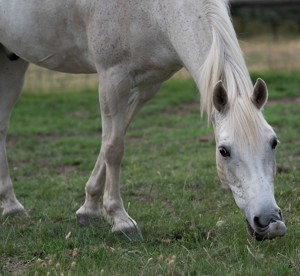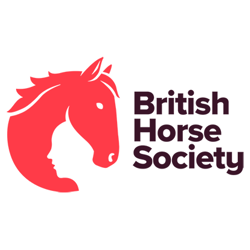Equines are herbivores and have a complex digestive system to break down and digest nutrients from plant material. Horses forage for 18 hours per day1 because their digestive system only needs a small amount of food passing through it continuously to remain healthy.
The equine digestive tract is unique because it digests portions of feed enzymatically — first in the foregut and ferments in the hindgut. Domesticated horses are now offered a variety of feeds which often contain levels of starch which isn’t easily digestible. They also have a less natural lifestyle which doesn’t often allow for 24/7 grazing and roaming.
Mouth
The horses’ whiskers start off the digestive process by helping the horse to feel for their food source. The upper lip of the horse is incredibly strong, mobile and sensitive, allowing them to move forage to their incisor (front) teeth. The lips also form a funnel shape to suck water into the mouth. The incisor teeth cut the forage and the tongue helps to guide it into the mouth. The tongue then moves the food further back into the mouth to the molar (cheek) teeth. These teeth grind the food down, known as mastication.

When the horse chews, the salivary glands excrete saliva to help lubricate the chewed food into a bolus. A bolus is a mass of chewed food which is then swallowed. Saliva contains a substance known as bicarbonate, which helps to buffer the acid found in the stomach. A horse which is fed a natural, forage-based diet can produce between 10-12 litres of saliva per day2.
Oesophagus
The oesophagus is a muscular tube approximately 1.2-1.5m long. It creates a wave like motion known as peristalsis to help move the bolus down towards the stomach. A bolus that hasn’t been chewed enough or not lubricated sufficiently can become stuck and cause choke, which is why routine dental checks are encouraged. To prevent the swallowed food from passing into the respiratory system, the epiglottis will block off the entrance to the trachea.
Cardiac sphincter
The bolus will then pass out of the oesophagus through a one-way valve known as the cardiac sphincter and into the stomach. This sphincter is incredibly strong and is what prevents horses from being able to vomit. Due to this, horses are at greater risk of colic episodes and swelling of the stomach. If the stomach becomes distended, it’s at risk of rupturing so it’s important to always call your vet if you’re concerned.

Stomach
The stomach of a horse is relatively small in comparison to their overall size. For an average horse it’s roughly the size of a rugby ball and has a capacity of 8-12 litres3. Due to the capacity, small frequent meals are recommended as the stomach cannot expand. If the horse is fed a large meal, there’s a risk that unprocessed food from the stomach will pass into the small intestine causing upset such as colic. Proteins and fats start to be digested here but little nutrient absorption occurs.
The stomach can be broadly split into two sections which are lined differently. The upper part of the stomach is known as the squamous mucosa, and the lower the glandular mucosa which secretes stomach acid and enzymes to help start digestion. To protect the stomach wall the glandular mucosa is lined with a thick layer of mucus which the squamous mucosa doesn’t have. Hydrochloric acid is continuously secreted by glands to start the breakdown of food and continues to be produced even when the horse isn’t eating. When natural feeding habits aren’t replicated, this increases the risk of gastric ulcers1.
The stomach will empty when it’s around two thirds full, regardless of how long the food has been there. It will then pass through the pyloric sphincter and into the small intestine.
Small intestine
Three sections make up the small intestine (SI): duodenum, jejunum and ileum. The duodenum starts the SI and is approximately one metre long. Food is broken down further into basic nutrients by enzymes secreted by the pancreas and liver. Bile is continuously secreted by the liver as the horse doesn’t have a gall bladder in which to store it.
The jejunum is the longer (around 19 meters), more folded part of the SI and finishes off most of the digestion using enzymes. Nutrients such as starch, fats and proteins are absorbed through the gut lining into the blood stream for use straight away or to be stored in the liver.
The ileum is the final part of the SI and is around one metre in length. The ileum continues absorbing nutrients but also controls the passage of food into the large intestine (LI). At this point the only non-digested matter should be fibre and water.
Digestion in the small intestine can be rapid4 with some food passing to the LI in around 45 minutes. However, volume of food alongside quick passage times can limit the amount of digestion which takes place and can cause issues in the LI, meaning that trickle feeding is best suited.
Large intestine
The LI makes up the hindgut and consists of the caecum, large colon, small colon and rectum – the total length being approximately eight meters long.
The caecum is an essential part of the system for a horse and can hold a volume of approximately 35 litres2. The caecum is essentially a huge vat which contains millions of specially adapted bacteria called gut flora. The gut flora are vital in breaking down fibre but are incredibly sensitive which is why all changes to diet should be made gradually. Sudden changes to their diet may cause issues such as diarrhoea, colitis, colic and laminitis. The gut flora break down fibre by fermenting it which creates heat and acts as the horse’s inbuilt central heating system.
If undigested starch from the SI enters the caecum, the flora tries to break it down quickly which creates lactic acid. This lactic acid can cause the environment to become too acidic killing off the vital bacteria and causing further issues such as acidosis of the gut lining5.
From the caecum, the food material passes into the large colon which is 3.5 metres long and can hold up to 90 litres. The large colon fits into a small area within the horse’s abdomen, meaning it has to fold and create tight turns, making it vulnerable to food becoming stuck – also known as impaction colic. These impactions usually occur due to a sudden change in routine, such as going from 24/7 turnout to being stabled. A large amount of water is absorbed in the large colon.
The small colon continues to absorb water and electrolytes into the body, and any food matter left will pass into the rectum where the faecal balls form. The rectum is around 30cm long and passes to the anus which expels faeces.
References
- Warren, H. (2015) The equine digestive system and the importance of the hindgut. Digestive health and the modern horse. Pp. 7.
- Frape, D. (2008) Equine nutrition and feeding.
- Auwerda, P. (2023) Digestive anatomy and physiology of the horse.
- Santos, A. et al., (2011) Understanding the equine cecum-colon ecosystem: current knowledge and future perspectives. 5 (1) Pp. 48-56.
- Davies, Z. (2009) Introduction to horse nutrition.
Get in touch – we’re here to help
The BHS Horse Care and Welfare Team are available to offer you advice and support with any questions or concerns you may have.
Don’t hesitate to call us on 02476 840517* or email welfare@bhs.org.uk – You can also get in touch with us via our social media channels.
Opening times are 8:35am-5pm from Monday – Thursday and 8:35am-3pm on Friday.
*Calls may be recorded for monitoring purposes.



